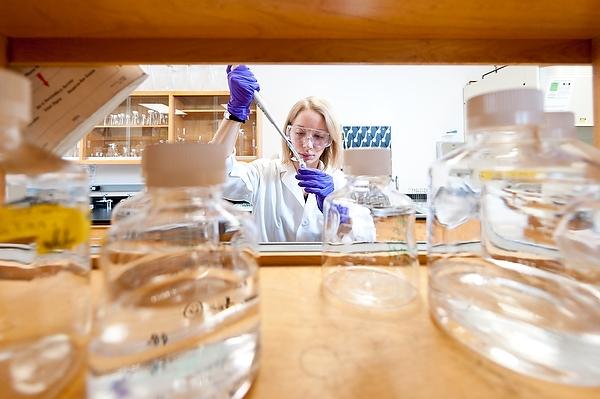Researchers at the University of Wisconsin have made a giant leap forward in understanding the three-dimensional structure and mechanism of an enzyme that degrades Toluene, which could provide a solution to oil spills.
The research was a collaboration between Department of Biochemistry chair and professor Brian Fox and his team. The team included UW students Justin Acheson and Lucas Bailey and UW chemistry professor Thomas Brunold.
This research is a step forward for helping chemists design new chemicals that may lead the way in finding solutions to environmental issues such as oil spills, Fox said.
Fox said they were interested in the 3-D structure of this Toluene-oxidizing enzyme and how it works. Toluene is commonly found in oil and wood. The researchers were recently able to trap the toluene in this oxidation process.
“If you are able to trap something like that it gives you a lot of understanding that you can only guess about,” Fox said.
UW chemistry graduate students receive prestigious national fellowship
This research examines the first step in a natural process, known as bioremediation where bacteria utilize an enzyme to consume Toluene carbon atoms.
In this process, iron atoms in the enzyme react with oxygen atoms nature and then surround Toluene molecule. This allows the exchange of electrons and for the bacteria to consume the molecule.
Bacteria consuming the molecule could clean up oil spills and other chemical spills involving Toluene.
“I got involved about a year ago as a member of Justin’s thesis committee,” Brunold said. “Justin had these amazing X-ray crystal structures of enzyme intermediates [iron-oxygen intermediate involved in this process]. These structures show the positions of atoms but do not provide unambiguous information about the metal oxidation states.”
The locations of these electrons is important because it influences how the bacteria surround and consume the Toluene molecule, Brunold said. This, in turn, impacts how oil spills can be cleaned up.
Humanities, social science courses experience enrollment decrease, while STEM courses rise
This research will allow for better understanding of how such a class of powerful enzymes work, Fox said.
“[The enzymes] do everything from making DNA molecules to unsaturated fats and making antibiotics to degrading toxic chemicals in the environment,” Fox said.
Fox said it took many years for him and his team to map the actual crystal structures of the enzyme’s intermediates before this step in the research.
Brunold said enzymes with similar active sites have evolved to catalyze their reactions at the highest possible rates while also suppressing undesired side reactions.
The enzyme uses a relatively mild oxidant in place of harsher oxidants that are often used, which is one advantage of the enzyme, Brunold said. Using too much of this harsher oxidant could be harmful for the environment and counterproductive to cleaning oil spills.
Your smartphone could soon tell if the air you are breathing is clean
“We hope synthetic chemists will be inspired to generate structural and functional models of these enzyme active sites,” Brunold said.


